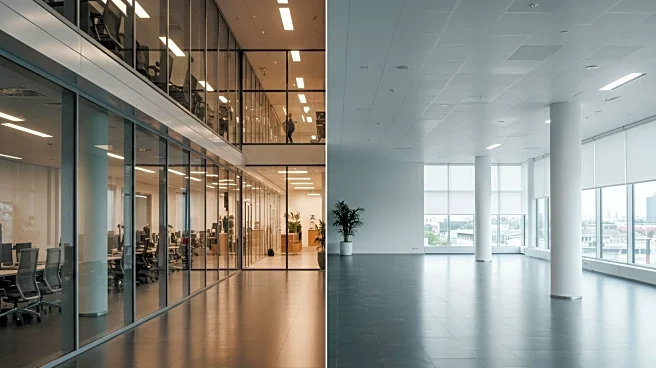What's Happening?
CBRE's 2025 U.S. Real Estate Market Outlook Midyear Review highlights a growing divide in the U.S. office market, with a notable gap between prime and non-prime vacancy rates. As of the second quarter of 2025, the prime vacancy rate stands at 14.5%, which is 4.8 percentage points lower than the non-prime rate. This gap is expected to widen due to a sustained flight to quality spaces and limited new supply. The report also reveals that many U.S. office occupiers are achieving their attendance goals but are still grappling with hybrid work dynamics. According to CBRE's 2025 Americas Office Occupier Sentiment Survey, 51% of organizations expect workers to be in the office three days a week, while smaller businesses often require more frequent attendance. Despite meeting attendance goals, discrepancies persist between expectations and actual show-up rates, particularly among larger companies.
Why It's Important?
The bifurcation in the office market underscores a significant shift in corporate real estate strategies, with a focus on quality over quantity. This trend could lead to increased demand for high-quality office spaces, potentially driving up rental prices in prime locations. The persistence of hybrid work models presents challenges in maintaining office vibrancy, affecting employee experience and corporate culture. Organizations are increasingly measuring attendance and enforcing policies to optimize office use, which could influence future workplace designs and real estate investments. The growing concern over the availability of quality spaces suggests potential constraints in office expansion plans, impacting businesses' ability to adapt to evolving work patterns.
What's Next?
As the gap between prime and non-prime office spaces widens, companies may need to reassess their real estate portfolios to ensure they meet employee expectations and business needs. The focus on team synchronicity and strategic office use could lead to new workplace policies and designs aimed at enhancing office vibrancy. Businesses might also explore innovative solutions to address space challenges and anticipate future needs. The ongoing shift towards quality spaces may prompt real estate developers to prioritize high-quality, well-located office buildings, potentially reshaping urban landscapes and influencing market dynamics.
Beyond the Headlines
The emphasis on quality office spaces reflects broader cultural and economic shifts, as companies seek to balance cost-efficiency with employee satisfaction and productivity. This trend may drive long-term changes in urban planning and commercial real estate development, with implications for sustainability and community engagement. The hybrid work model's impact on office vibrancy highlights the need for adaptive strategies that consider employee well-being and organizational goals, potentially influencing future workplace norms and societal expectations.

